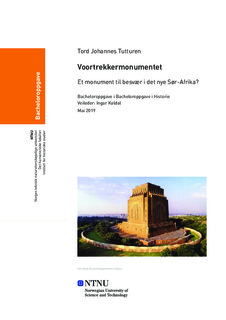| dc.description.abstract | Voortrekkermonumentet ble bygget for å hedre Det store trekket tidlig på 1800-tallet og afrikandernes kolonisering av Sør-Afrikas indre. Denne oppgaven vil bruke begreper og modeller fra historiebruksfeltet for å forstå hvordan historiebruken ved, og funksjonen til, Voortrekkermonumentet har utviklet seg. Det ble bygget for fremme en bestemt historieforståelse som skulle styrke afrikandernasjonalismen i sin samtid. Budskapet i monumentet og den politiske bruken av det på 1930-40-tallet legitimerte afrikandernes plass i Sør-Afrika og makten til å styre over de svarte. Maktskiftet i 1994 har ført til endringer i det sørafrikanske minnelandskapet, dette har også påvirket Voortrekkermonumentet. I dag har monumentet et utvidet sitt tilbud til besøkende og flere aspekter ved afrikandernes historie og kulturarv er nå representert. Basert på forskning på det monumentet og den sørafrikanske minnetradisjon, vil jeg argumentere for at dette er et uttrykk for en indre mangfoldiggjøring. Ytre sett er Voortrekkermonumentet en del av et større minnelandskap. Staten har valgt å kommentere og balansere de gamle monumentene med nye, i håp om at en bredere representasjon skal føre til forsoning og forbrødring. Monumentet har blitt balansert av Freedom Park like ved. Oppgaven undersøker om denne mangfoldiggjøringen kanskje er et uttrykk for en bredere og mer inkluderende historiebevissthet i den offentlige historiebruken i Sør-Afrika. | |
| dc.description.abstract | The Voortrekker Monument commemorates the Great Trek of the early 19th century and the Afrikaner conquest of the interior of South Africa. This dissertation aims to use concepts and models from the field of public history theory in order to understand the development in the use of history at, and the function of, the Voortrekker Monument. The monument was built to promote a certain historical narrative that supported the Afrikaner nationalistic ideology of the times. The message of the monument, and the political use of it in the 1930s-40s, justified the Afrikaners’ presence in South Africa and their power to rule over the black population. After the change of government in 1994, the South African commemorative landscape has adopted a multiplicative commemoration strategy, which also has affected the Voortrekker Monument. Today the Voortrekker Monument is offering its visitors a wider range of experiences, not only in terms of recreation but also by the fact that more aspects of Afrikaner history and cultural heritage are now represented. Based on research on the monument and on the South African commemorative tradition, I would argue this is partly the result of an internal multiplicity. Externally the Voortrekker Monument is, arguably, a part of larger commemorative landscape. The government has chosen to comment and balance the old monuments with new ones, hoping a broader representation will lead to reconciliation and unity. The Voortrekker Monument is, in that regard, “balanced” by Freedom Park close by. Lastly, this dissertation suggests that this diversification may be a manifestation of a broader and more inclusive historical consciousness in South Africa’s public history. | |
